Making your own all natural herbal salve is so easy! This salve is the perfect beginner herbal medicine recipe for a beginning herbalist. Use it on minor cuts, scrapes, bruises, bites, stings, rashes and dry skin. It has powerful healing benefits with all of the medicinal herbs it contains, and smells divine! Learn how to make an herbal salve using herbs and plants you can find in your own backyard or grow in your garden.
Homemade Herbal Salve Recipe
I’m so excited for this post as this is something that I’ve been wanting to do for a long while! If I had known how easy this is I would have done it years ago.
I’m going to show you how to make an herbal salve with herbs that you can forage or are most likely growing in your garden.
The best part about it is that you can use any number of herbs, it doesn’t have to be the exact ones that I show you here, as there are many that have powerful healing properties.
Choosing and Drying Herbs for Herbal Salve
Alrighty, lets get into the details of this salve making!
The first step in the process is to make an herbal oil infusion, which sounds a lot more complicated than it actually is. There are a few different ways to do this, but the first thing you need are herbs.
For this salve I used plantain leaves, comfrey leaves, yarrow leaves and flowers, lavender flowers, and lemon balm leaves.
There are many other medicinal plants and herbs that can be used, such as calendula, St. Johns wort, dandelion, and arnica to name a few.
I foraged the herbs for this salve, but you can also purchase high quality, organic dried herbs from Mountain Rose Herbs.
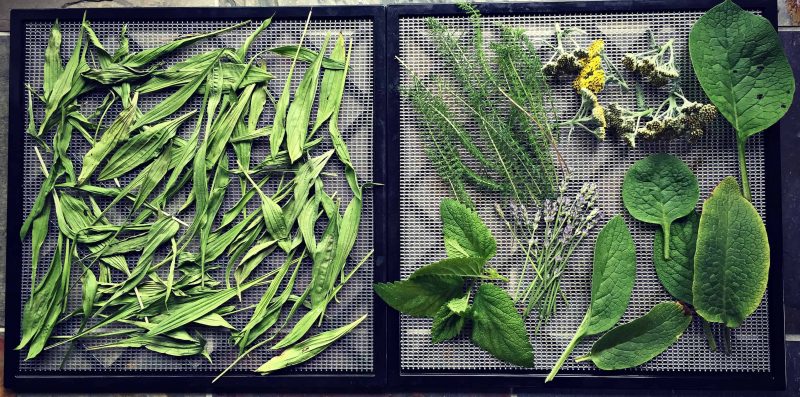
Want to save this post for later?
If you are using freshly foraged or homegrown herbs you will need to dry them first.
Hang them upside down for several weeks, use a drying screen, or if you need them in a hurry and you happen to have a food dehydrator (Excalibur is best), you can use that as well.
Since I was making yogurt in my dehydrator already, I decided to do double duty and dry my herbs at the same time.
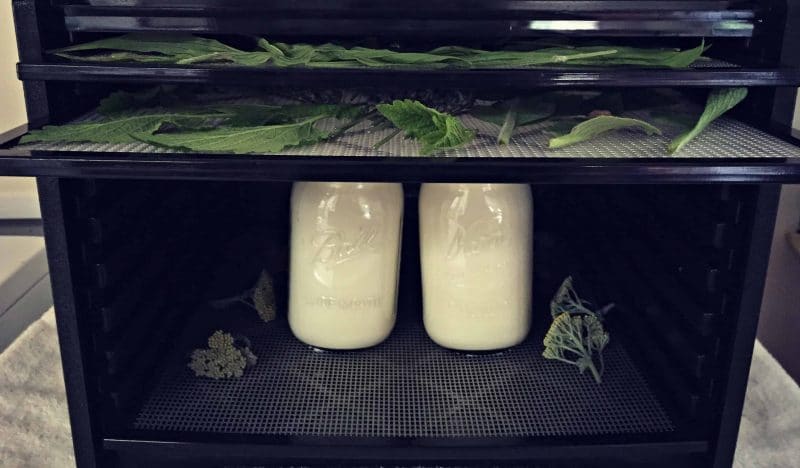
In general, it’s important to make sure that your herbs are completely dry before you make your oil infusion or else mold can form and it will go rancid.
There are a few herbs that are better infused fresh however, such as St. John’s wort.
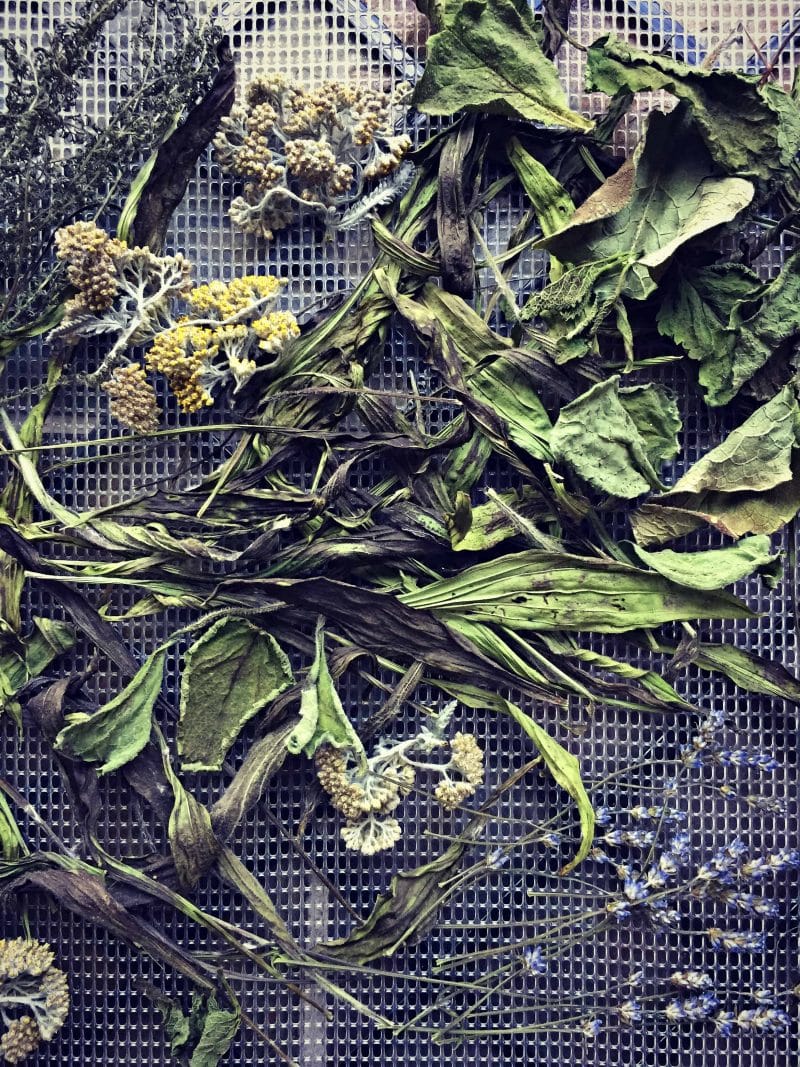
Make the Herb Infused Oil
Now it’s time to make your infused herbal oil. There are a few of ways to do this, the first is to simply put your dried herbs in oil and let it sit in a cool place out of direct sunlight for several weeks.
I will often gently heat my oils as they’re infusing in my dehydrator a few times to help the process along.
You can use several different types of oil for your infusion, but olive oil is the most common. I also like to use coconut oil.
If you need your infused oil sooner, or if you want to use coconut oil which is usually solid at room temperature, you can gently heat the herbs in the oil over a double boiler or in a slow cooker on low heat.
I was short on time and wanted to use some coconut oil, so I decided to go with this method. Plus, I recently acquired a slow cooker that came with a second mini slow cooker, and I discovered that this is the perfect use for it!
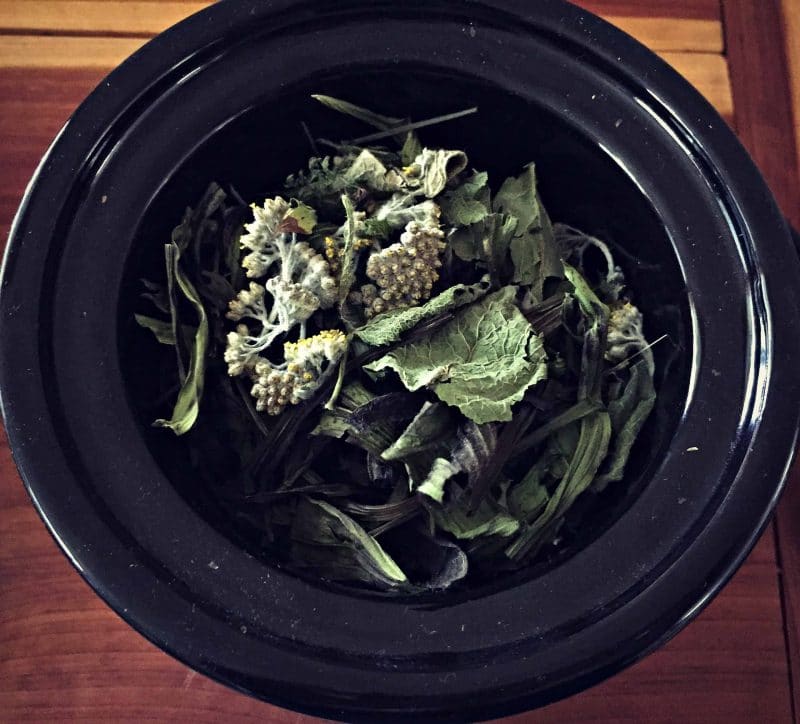
Crush up your dried herbs a bit and put them in your vessel, then cover with oil. I used a combination of olive and coconut oil, a total of approximately 1 ½ cups. The more oil you make, the more salve you can make.
Heat for several hours, making sure that it doesn’t get too hot and cook the herbs. I did this in the evening and turned off the heat before bed, letting the herbs continue to steep overnight.
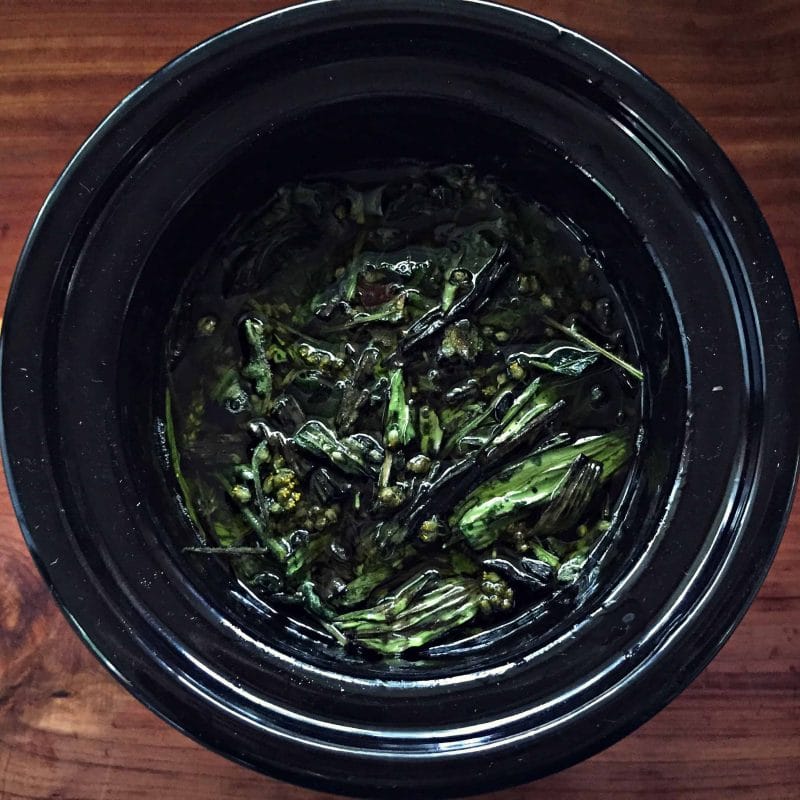
Make the Herbal Salve
The next morning I had a very fragrant herbal oil infusion! Strain it with a sieve and cheesecloth into a bowl that you will be able to use as a double boiler.
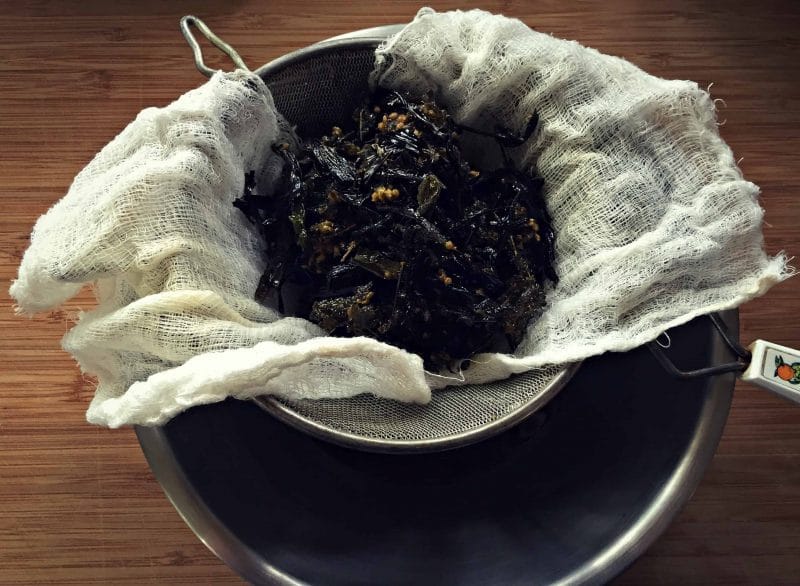
Use the cheesecloth and squeeze every last bit of oil into the bowl. Now that you have your herbal infusion, it’s time to gather the rest of the necessary ingredients.
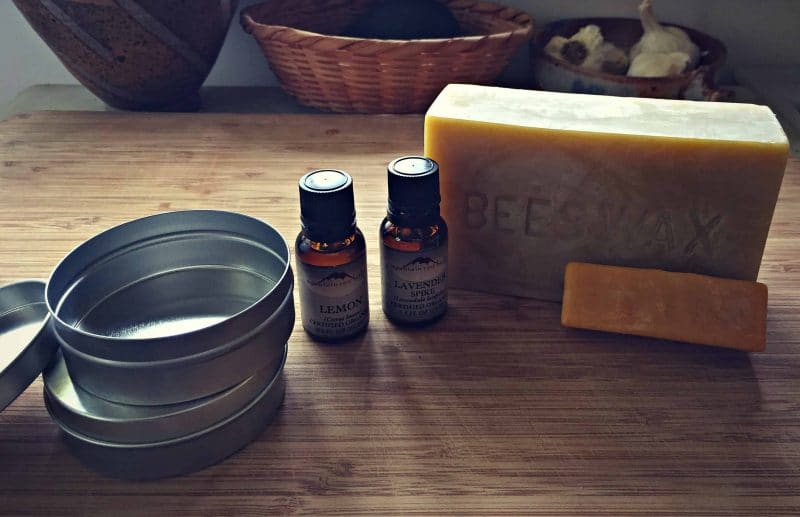
Beeswax (or carnauba wax for vegans), essential oils of your choice, and some sort of vessel to put your finished salve in (such as jars or tins) is all that you’ll need besides the infused oil.
I use about 1 ounce of beeswax (one small stick) per cup of infused oil, and lavender and lemon essential oils, to accentuate the lavender flowers and lemon balm in the salve.
Now everything comes together quite quickly. Put your bowl of herb infused oil onto a pot of boiling water, double boiler style. Cut your wax into chunks and add it to the warm oil.
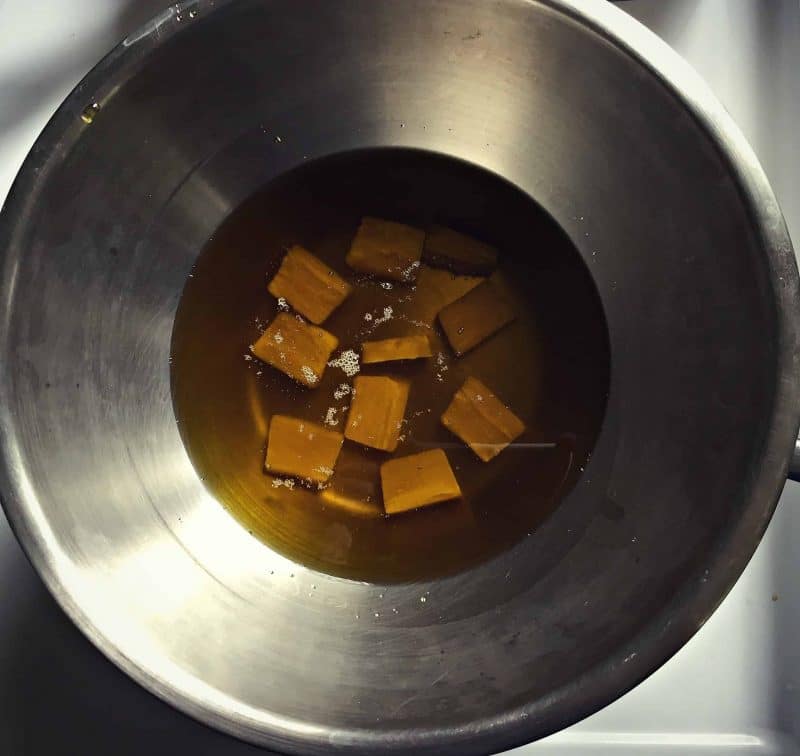
Once the oil heats up the wax should melt fairly quickly. When it’s completely melted, take the bowl off the heat (it’s probably hot!) and add drops of the essential oils. I did 12 drops of lavender and 6 drops of lemon.
Then carefully pour the salve mixture into the tins or jars.
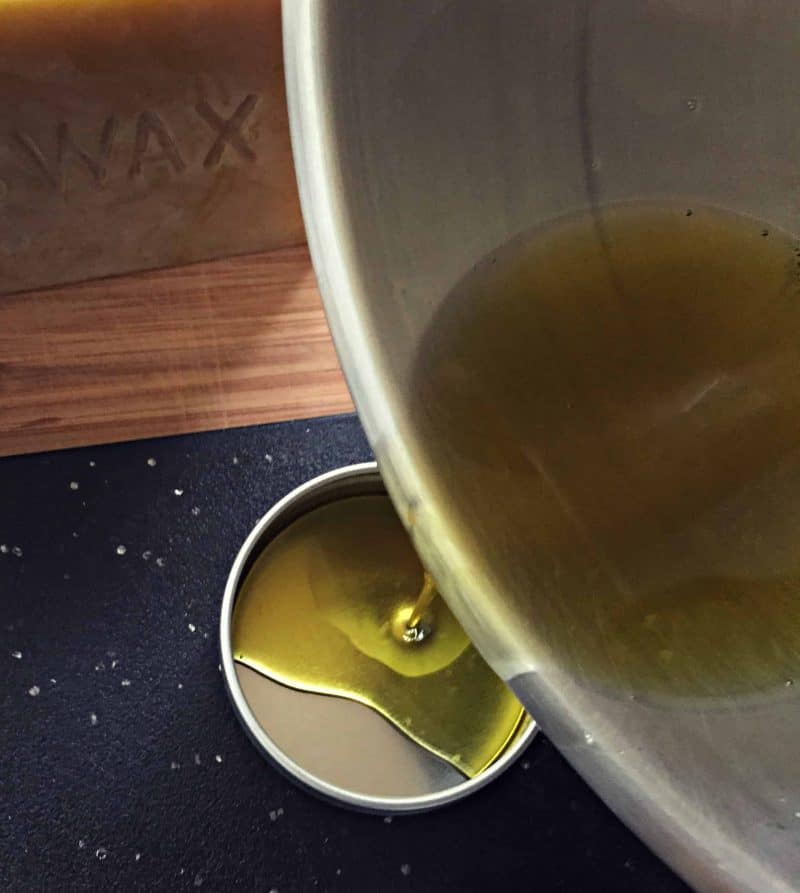
This batch that I made yielded two 4 ounce and two 2 ounce containers. I like to make various sizes so that I can stash them in different places such as my purse or the car.
Once the tins are full let them sit undisturbed for a few hours to solidify.
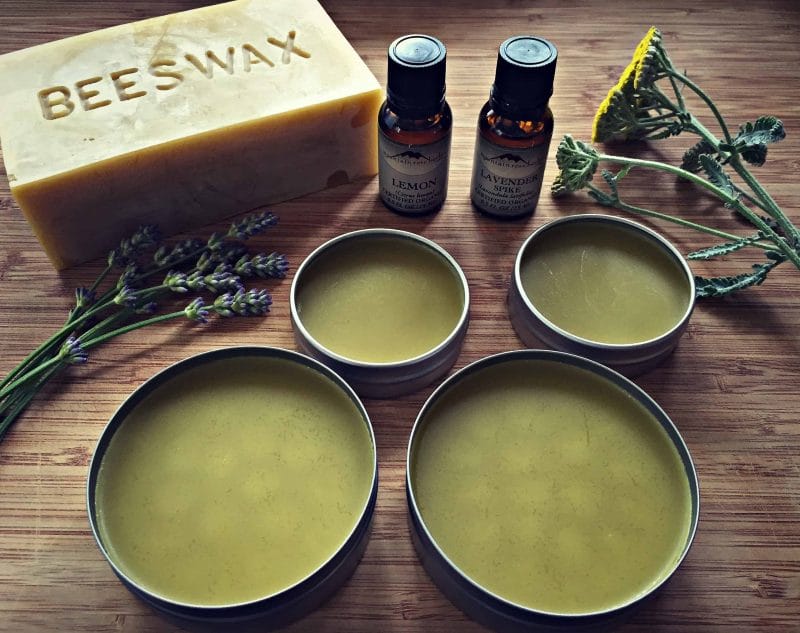
That’s all there is to it! It’s pretty amazing what we can make at home with just a few simple ingredients and a bit of time.
This herbal salve is good for minor cuts, scrapes, bruises, bites, stings, rashes and dry skin. I use it on my hands and feet all the time.
Not only does it have astounding healing powers with all of the medicinal herbs that it contains, but it smells absolutely divine!
You can also make this into a lip balm if you’d like, simply add more a bit more beeswax to help it hold up better on your lips.
Lip Balm Recipes
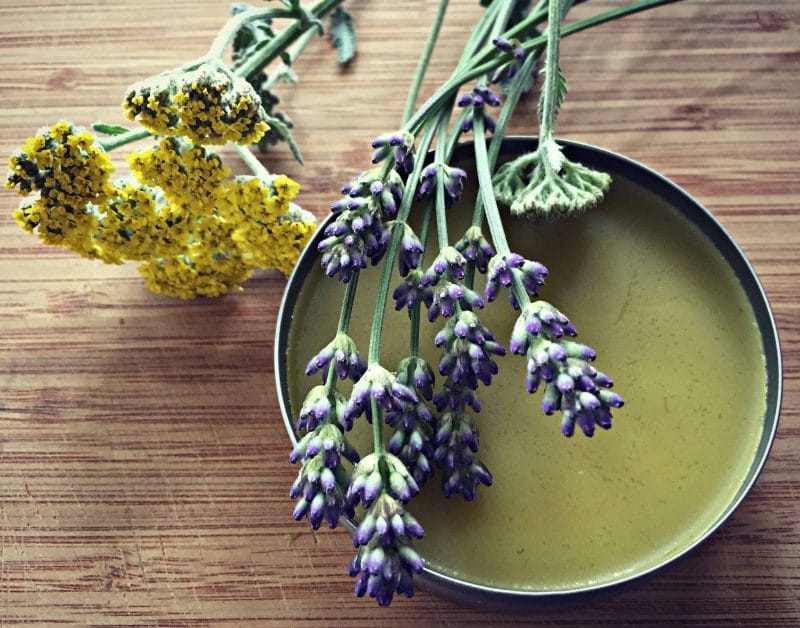
More Herbal Salve Recipes
- Dandelion Salve
- Yarrow Salve
- Plantain Salve
- Calendula Salve
- St. John’s wort Salve
- Bug Balm
- Comfrey Salve
- Manuka Honey Salve
- Diaper Rash Salve
- Pine Salve
Happy herbal salve making!
Herbal Salve
Ingredients
Herb Infused Oil
- 1 ½ cups carrier oil of choice olive, coconut, and/or sweet almond work well
- 1 cup dried herbs plantain, yarrow, comfrey, lavender, calendula, and/or lemon balm are all great options
Herbal Salve
- 1 cup herb infused oil
- 1 ounce beeswax
- 12-24 drops essential oils of your choice optional
Instructions
Herb Infused Oil (slow method)
- Put the dried herbs in a pint jar and cover with carrier oil.
- Cover and place in a cool spot out of direct sunlight for 4-6 weeks.
- Strain the herbs and reserve the oil for making salves.
Herbal Salve
- Heat the infused herbal oil in a double boiler. You can use a metal bowl or glass pyrex measuring cup over a pot of water if need be.
- Add the beeswax and stir until it completely dissolves.
- Remove from heat and stir in the essential oils.
- Carefully pour the mixture into jars or tins and set aside until the salve solidifies.
Notes
- Plantain leaves, comfrey leaves, yarrow leaves and flowers, lavender flowers, and lemon balm leaves would all make great choices for your herbal oil infusion.
- You can alternatively use the quick method for making infused oils by heating the oil and dried herbs in a pot on low heat for up to 12 hours, but the infused oil may not be as potent.
- I did 12 drops of lavender and 6 drops of lemon essential oils.
- Use the herbal salve on minor cuts, scrapes, bruises, bites, stings, rashes and dry skin.

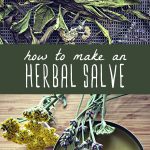
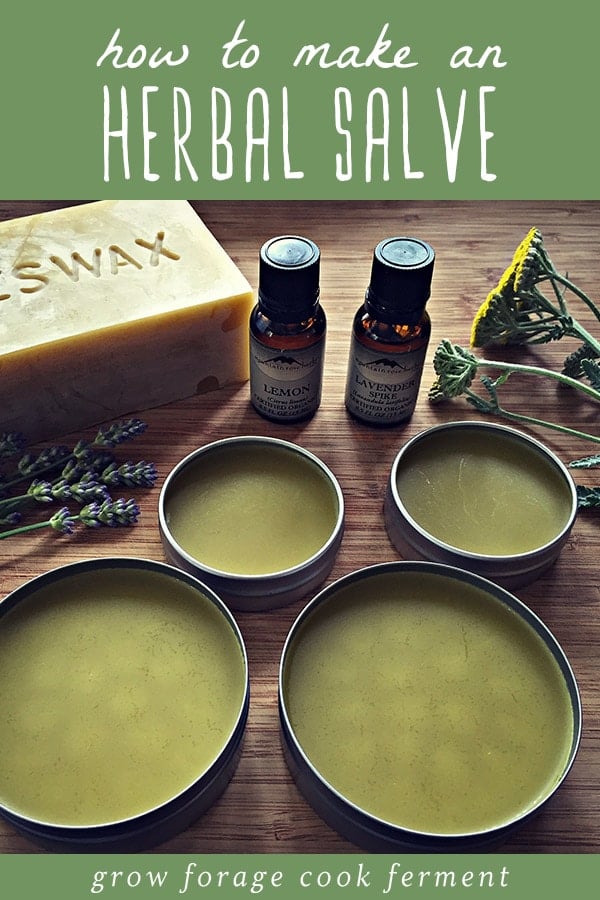
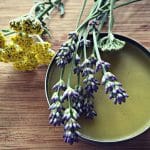

How much herbs should I use for this?
Is it possible to use aloe vera as a substitute for the dry herbs? Thanks for very clear instruction
I’ve never tried it with aloe vera, so I’m not sure how it would turn out. Usually you want to use dried herbs because the water content in fresh herbs can promote rancidity.
Aloe Vera needs to be refrigerated after being expressed as it can go bad, and is better when fresh(there are herbs that can prevent and extend but you also begin altering the chemical structure as well). If using for burns though, a mix of fresh expressed aloe, honey (raw) and lavender and a bit of tea tree essential oil is one of the best I’ve used to date, and wrapped in gauze during sleep and/or travel- this prevents the gauze from sticking as well as the burns from drying out and cracking, as well as promotes healing and preventing a serious infection.
I’ve heard that you can infuse oil with fresh aloe but I have never tried it myself.
I have herbs infusing as I type. I just need to get the essential oils I want to put in it. I haven’t been aboe to get as many as I’d like due to $$ constraints lol
This is awesome information.
No, I haven’t but I can if I win this giveaway of great products!
I started only buying natural products a couple of years ago but I have not yet tried making my own remedies. It is something I hope to learn more about.
9 years ago I became facinated with the prospect of plants healing us. That the healing power of nature trumps the chemically, man-made pharmaceutical products. They are safer, healthier and smell better. When used internally (i.e. tinctures, infusions, teas, syrups and more), the immune system is amplified instead of depressed. We are sick less or alternatively, become well faster and we feel better. I created my first tincture and salve through a pre-booked kit from a great company. I took raw materials and transformed them into medicine! I was excited and eager to learn all I could. I dreamed of the day I could study herbalism and get that knowledge “under my belt,” so to speak. I’m proud to say, in 2012, while pregnant with my first child, I earned my Master Herbalism diploma through GCNM via online schooling. Good luck to all! I applaud you in your search for natural medicine, to heal yourself and your families! It’s worth the time and the financial investment. Happy herbing!
I would really like to try this recipe
I have made several salves and my family loves them. We love making our own herbal remedies!
I’ve made fire cider, decongestant, poultices but not salves yet!
I’m infusing oil for a dandelion salve right now. I’m hoping it turns out okay. I had people tell me that the flowers needed to be fresh not dried, but I let the flowers sit for a few days to wilt and dry a little bit because I read that the moisture content of the flowers can cause the salve to go bad. Hopefully it turns out okay…I have my beeswax and coconut oil ready…just realized that perhaps I should get some tins….haha.
I made quite a few mild soaps for hair, body, pets and people with skin eczema. I also made my own diaper rash cream when my kiddo was little.
I love your salve! Thank you for sharing your recipe.
Recently I put similar herbs to infuse in olive oil for the salve – comfrey, plantain, calendula, camomile, chickweed. I learned that plantain and chickweed have to be fresh though… so I only did the quick wilt with them.
I havent tried to make a salvr yet. Ibam looking for a replacement for vicks vap o rub. My roommate uses it every night for a nail infection. It is working but would like to replace
I have made hard lotion bars….kept my hands feet and elbows from cracking this last winter! It was a rough one in the North East! Would love to make these, thanks for all the great info and recipe!
This is a wonderful post! I have not tried making salves yet, but have made infusions and tinctures.
Looking forward to making this salve. I added many new herbs to my herb garden to try new things this summer/fall. Thank you.
I just got some herbal salve yesterday from a local artisan. Can’t wait to make my own :)
definitely want to try this!
I make a salve with plantain, beeswax and olive oil. Awesome for any skin conditions!
I am going to try to sell a salve with arnica and other herbs like this at our local farmers market!
Over the winter I made ginger, honey, lemon, mint tea and I stayed healthy while everyone around me got colds and flus.
Thank you for the fabulous directions!! Can’t wait to try your recipe :)
I think the only thing that I’ve made that classifies as healing would be a tummy tuck cream.
This salve is amazing!!! It healed my husband’s second degree burns with no scarring after a molten aluminum project went awry. We haven’t purchased antibiotic cream in 10 years. I need to make a new batch, almost out!
Wow! I’ve been a bit intimidated to make a salve, but your post is so informative that I think I just may give it a try now!
I haven’t made any salves yet, but I’ve been wanting to try it- we’ve got lots of plantain growing around our house!
Thanks for sharing this tutorial. I look forward to checking out more posts :) I have made soap, lip balm, deodorant and body butter and look forward to trying this salve.
I’ve made my own toothpaste using coconut oil and essentials oils. :)
Thank you, you have made it look easy and uncomplicated. I am going to bookmark this page. This looks like fun.
will be trying
Great giveaway, giving this a try , it seems easy to follow- great directions.